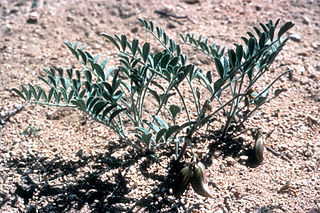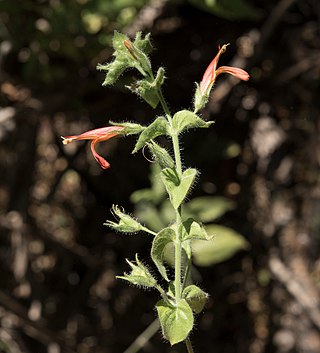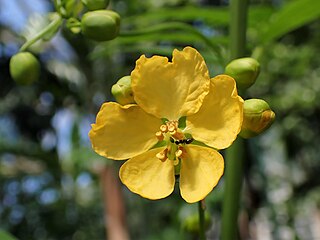
The Mimosoideae are a traditional subfamily of trees, herbs, lianas, and shrubs in the pea family (Fabaceae) that mostly grow in tropical and subtropical climates. They are typically characterized by having radially symmetric flowers, with petals that are twice divided (valvate) in bud and with numerous showy, prominent stamens.

Astragalus is a large genus of over 3,000 species of herbs and small shrubs, belonging to the legume family Fabaceae and the subfamily Faboideae. It is the largest genus of plants in terms of described species. The genus is native to temperate regions of the Northern Hemisphere. Common names include milkvetch, locoweed and goat's-thorn. Some pale-flowered vetches are similar in appearance, but they are more vine-like than Astragalus.

Astragalus bibullatus, the limestone glade milkvetch or Pyne's ground plum, is an endangered species of flowering plant that is endemic to the cedar glades of the central basin of Tennessee in the United States. It is found in only eight populations located within a few kilometers of each other in Rutherford County, Tennessee.

Astragalus lemmonii, the Lemmon's milkvetch, is a rare plant of eastern California. It is a member of the bean family, the Leguminosae, and specifically a member of the subfamily Papilionoideae. The genus Astragalus is a large genus within this family; members of this genus are known as milkvetches or locoweeds. Close relatives of this particular species include Astragalus peckii and Astragalus lentiformis.

Astragalus lentiginosus Astragalus lentiginosus is a species of legume native to western North America where it grows in a range of habitats. Common names include spotted locoweed and freckled milkvetch. There are a great number of wild varieties. The flower and the fruit of an individual plant are generally needed to identify the specific variety.

Astragalus brauntonii is a rare species of milkvetch known by the common name Braunton's milkvetch. It is a short-lived perennial shrub with lilac flowers that is typically found on carbonate soils in fire-prone areas. It is a opportunistic pioneer species that usually appears in the aftermath of wildfires and other disturbances. It is known from fewer than 20 extant occurrences in the hills and mountains surrounding the Los Angeles Basin in Southern California, as well as an isolated population in northern Baja California.

Astragalus ertterae is a rare species of milkvetch known by the common name Walker Pass milkvetch. It is endemic to California, where it is known from only three occurrences near Walker Pass in the Sierra Nevada. It is endangered by trampling, trail use, and also grazing.

Astragalus pomonensis is a species of milkvetch known by the common name Pomona milkvetch. It is native to Baja California and southern California, where it can be found in a number of coastal habitats, including the California Coast Ranges. This is a bushy perennial herb forming a clump of thick, hollow stems up to about 80 centimeters tall. Leaves are up to 20 centimeters long and are made up of many oval-shaped leaflets each up to 3 centimeters in length. The inflorescence is a large array of up to 45 cream-colored flowers. Each flower is between one and two centimeters long. The fruit is a bladdery legume pod which dries to a thin, almost transparent papery texture. It may exceed 4 centimeters in length and generally drops off the plant when dry.

Charles F. Harbison (1904–1989) was an American entomologist and the curator of entomology at the San Diego Natural History Museum from 1942 to 1969. An avid field naturalist and researcher, Harbison influenced a generation of San Diego-born scientists in many fields of natural history through the Junior Naturalist program at the museum.

Astragalus aquilonius, the Lemhi milkvetch, is a species of milkvetch in the family Fabaceae. It is native to Idaho.

Dudleya anomala is a rare species of succulent plant in the family Crassulaceae commonly known as the Todos Santos liveforever. With a dense, cushion-forming habit, this leaf succulent is characterized by elongated stems, slightly sticky leaves, and bell-shaped flowers with white, spreading petals. This species is native to Baja California, Mexico, and is found primarily on islands and one coastal locality.

Dudleya campanulata is a species of perennial succulent plant known by the common name as the Punta Banda liveforever, native to Baja California and endemic to the Punta Banda peninsula, a promontory south of Ensenada that encloses the southern limit of the Bahía de Todos Santos, a deepwater bay. One of many species of Dudleya native to the peninsula and surrounding islands, it is distinguished by its campanulate flowers and its occupation of a narrow habitat that consists of ocean bluffs on the southern end of the Punta Banda, near the well-known blowhole La Bufadora.

Dudleya cultrata is a species of perennial succulent in the family Crassulaceae commonly known as the knife-leaved liveforever or the maritime succulent liveforever. This species is characterized by oblong, narrow green leaves and flowers with pale yellow petals that bloom from April to June. Although similar to Dudleya ingens, this species is most often seen growing sympatric with the larger, wax-covered Dudleya anthonyi. It is native to Baja California, occurring on the coast from Punta Colonet and San Quintin to El Rosario.

Pometia is a genus of 2 species of rainforest trees, constituting part of the plant family Sapindaceae.

Ebenopsis confinis is a species of drought deciduous perennial shrubs in the Legume family known commonly as dog poop bush. The English vernacular name is a result of the distinctive woody fruits which resemble dog poop. The plant is referred to locally as palo fierro. In addition to the fruits, this species is characterized by its small, equally-paired pinnate leaves and a condensed capitulum. This species is distributed from southern Baja California to the cape of Baja California Sur, and on the coast of Sonora.

Justicia purpusii is a species of flowering plant in the Acanthus family commonly known as Purpus' hummingbird flower or chuparosa. This shrub is characterized by long orange-red tubular flowers that bloom from November to April. It is endemic to the Cape region of Baja California Sur, Mexico, where it is found growing in tropical deciduous forest and thorn scrub in canyons and along wet slopes. It is similar to its more northern relative adapted to drier climates, Justicia californica. Phylogenetic analysis has shown that both species are closely related and form a clade.

Senna barclayana, commonly known as smooth senna or pepper-leaf senna, is a species of flowering plant in the family Fabaceae and is endemic to eastern Australia. It is a herbaceous perennial or subshrub with pinnate leaves with six to ten pairs of lance-shaped or narrowly elliptic leaflets, and yellow flowers in groups of six to ten.

Senna cardiosperma is a species of flowering plant in the family Fabaceae and is endemic to the western half of Australia. It is an erect shrub or small tree with pinnate leaves, the number and shape of the leaflets depending on subspecies, yellow flowers with ten fertile stamens in each flower, and flat pods.
Senna flexuosa is a species of flowering plant in the family Fabaceae and is endemic to Western Australia. It is an erect or spreading shrub with pinnate leaves with ten to thirteen pairs of egg-shaped leaflets, and yellow flowers arranged in groups of three to five, with ten fertile stamens in each flower.

Astragalus anemophilus, or San Quintín dune milkvetch, is a species of milkvetch endemic to coastal sand dunes near San Quintin bay in the state of Baja California.





















